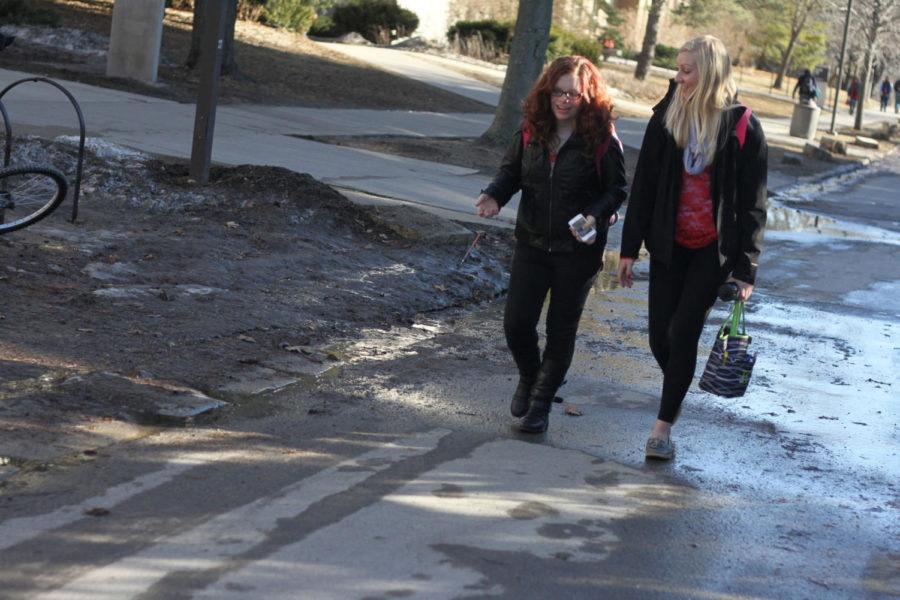Maxwell: Campus nature ruins ISU’s aesthetic
Dominic Spizzirri/Iowa State Daily
English education majors Emma Rodenburg, left, and Kristen Ahlers walk through mud that can be found throughout campus.
March 14, 2014
As the temperature outside rises and the snow melts away, the campus grounds of Iowa State once again reveal a muddy mess. The paths students normally travel now require rain boots, which are luckily back in fashion this year. As the grass that had been thankfully concealed by winter’s mercy starts to show through, it reminds us that there is much work to be done before any sane person would consider our campus beautiful.
Nature has been a burden on our campus since Iowa State first came into existence in 1858. Eventually, we were able to make it conform to what we consider beautiful — to the point that our campus could receive a medallion awarded for beauty shared by a mere 362 sites around the country, including the Grand Canyon, Disneyland and the landfill of Industry Hills, Calif.
We have allowed the wildlife to remain part of our campus, but because we have so much nature around, the fact that people on campus walk to get places is ignored. Sidewalks may help to direct foot traffic, but they are largely ineffective. Many paths have been carved by students walking through the areas on campus where our Facilities Planning and Maintenance department desperately attempts to grow grass. Trampling the grass is always more convenient, however, and the paths show everyone where to go.
The quaint dirt trails that encourage subsequent pedestrians to use the same route and bypass the sidewalk are true hallmarks of beauty. It is quite enjoyable for those adventurous enough to follow such unconventional paths. Students should indeed be encouraged to stray and to deviate from what is expected of them while they “choose their adventure at Iowa State.” However, such joy is lost when there is any form of precipitation and these paths turn from humble dusty trails into deep mud pits of despair. Simply replacing the areas currently filled by plant life with dirt is therefore not an ideal solution.
Fortunately, there is a modest way to solve these issues: pave the entire campus. The burden of maintaining flora on the grounds of Iowa State would be absolved. Various vermin present on the school grounds could then be forcibly — yet ethically — relocated by veterinary students.
Additionally, bicycle parking would no longer be a problem. With no grass to get in the way, our campus would soon be flooded by enthusiastic bicyclists — something we all know is lacking. Students currently forced to undergo constant phony biking at the gym would finally be free to actually enjoy their passion outdoors. Longboarders would not be unfairly required to carry their boards when encountering the unpleasant and squishy ground used to grow plants all around campus.
Efforts currently spent on tending fickle plant life could then be redirected to working with wonderfully predictable concrete or asphalt. Currently, Iowa State uses a great amount of resources to maintain the plant life on the nearly 2,000 acres that compose our campus. But paved surfaces do not require any maintenance, and can in fact survive for very long periods of time. For example, many ancient Roman roads are still in use today, much more than 1,000 years after being built.
It may be easy to assume that students appreciate the carefully maintained appearance of natural beauty on our campus, but most students are not even aware of the life they are trampling over on the way to class.
Besides, students should not be encouraged to become distracted by unimportant things such as nature or the simplicity of laying in the grass on a sunny afternoon.
They should be focused exclusively on coursework.
Even Iowa State’s own website contains pictures of students not being productive and using the nature on campus as an outlet for their boredom.
Clearly grass — as well as most natural scenery — is not useful on our campus. We are wasting too much effort and money on maintaining something hardly anyone here truly appreciates. Our university may not be an urban campus, but that does not mean we have to endure the unbearable beauty of Mother Nature, especially when we have the ability to replace it with something far better.







